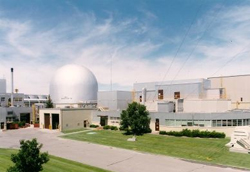Virgin Nuclear? Branson asks Obama for reactor help. Sir Richard v Bill Gates?
 Flamboyant British entrepreneur Sir Richard Branson has written to President Barack Obama seeking help commercializing an alternative type of nuclear reactor known as an Integral Fast Reactor.
Flamboyant British entrepreneur Sir Richard Branson has written to President Barack Obama seeking help commercializing an alternative type of nuclear reactor known as an Integral Fast Reactor.Branson wrote to the White House requesting a meeting with Obama and with Energy Secretary Steven Chu to discuss how integral fast reactors (IFRs) could rid the world of hazardous nuclear waste by burning it as fuel, while at the same time providing a more efficient and safer CO2-free source of energy than today’s conventional water-cooled reactors.
IFRs also reduce the risk of proliferating nuclear weapons, the letter points out.
“American companies would like to commercialize this technology and are prepared to begin building these reactors right away,” the letter to Obama states. “But we are convinced that this will not happen without your personal involvement and support.”
Branson, known for his Virgin brand of media and airline companies, isn’t the only well-known billionaire advocating IFRs, also known as “fast neutron reactors,” “fast reactors,” and sometimes as “breeder reactors.” Microsoft founder Bill Gates is developing a type of fast reactor known as a traveling wave reactor, through his startup company TerraPower.
Branson told me he has not invested money in an IFR or IFR company - unlike Gates, who is a primary shareholder in TerraPower. One might assume, however, that Branson would invest, should U.S. policy shape up favorably. That could set up the intriguing prospect of Branson versus Gates in the nuclear business (or who knows - the two could even partner).
“Obviously we urgently need to come up with a clean effective way of supplying our energy since not only are the dirty ways like oil running out but we need to do so to help avoid the world heating up,” Branson told me in an email.
That echoes the sentiments of the letter requesting a meeting with Obama, which the president declined.
The letter was written on Branson Necker Island stationary. Necker Island is the billionaire’s 74-acre patch in the Caribbean, a favorite hangout for Branson when he’s not racing hot air balloons or performing other publicity stunts, like jumping off the roof of a Las Vegas hotel or driving across the English Channel in an amphibious car.
 It was cosigned by two other individuals: NASA Goddard Institute head and Columbia University adjunct professor James Hansen, a renowned campaigner against man made climate change; and by Eric Loewen, who is the president of the American Nuclear Society and also the chief engineer on General Electric Hitachi’s IFR, called PRISM. Loewen signed the letter as the president of the ANS. GEH has proposed PRISM as a way to dispose of plutonium waste at Britain’s Sellafield nuclear facility.
It was cosigned by two other individuals: NASA Goddard Institute head and Columbia University adjunct professor James Hansen, a renowned campaigner against man made climate change; and by Eric Loewen, who is the president of the American Nuclear Society and also the chief engineer on General Electric Hitachi’s IFR, called PRISM. Loewen signed the letter as the president of the ANS. GEH has proposed PRISM as a way to dispose of plutonium waste at Britain’s Sellafield nuclear facility.“Unlike today’s nuclear reactor, the IFR can generate unlimited amounts inexpensive clean power for hundreds of thousands of years,” the letter states. “It provides an excellent solution for what to do with our nuclear wast because it can use our existing nuclear waste for fuel and it is significantly more proliferation-resistant than other methods of dealing with nuclear waste.
“The IFR is also inherently safe. In an emergency, unlike today’s reactors, it shuts down without human intervention and without requiring electric power… Hundreds of nuclear scientists believe this technology has the ability to generate carbon-free power at a cost per kW less than coal.”
Like with other hopeful alternative nuclear technologies such as thorium, the idea for IFRs has been around for decades. The U.S. ran a test IFR in Idaho from 1964 through 1994 called the Experimental Breeder Reactor II (after operating is predecessor EBR in the 1950s). EBR II is the basis for GE-Hitachi’s PRISM.
Critics say that IFRs are difficult to build, and question their safety. Japan’s Monju IFR suffered a leak and fire in 1995, and incurred another accident in 2010 when a fuel replacement device fell into the reactor. It is currently shut.
But proponents say that politics, not faulty technology, have been the bane of IFRs in the U.S., epitomized by the Clinton administration shut down of EBR II.
General Atomics in San Diego is also developing a fast reactor, called the Energy Multiplier Module, which it intends to sell in small sizes as a source of industrial heat and for electricity. China is developing IFRs and could rely on them heavily for CO2-free source of electricity by 2050, according to the World Nuclear Association. France, Russia and India also have fast reactor programs.
Branson and Gates might expect to compete against yet another familiar billionaire in the nuclear business. Amazon CEO Jeff Bezos has invested in General Fusion, a Burnaby, Canada company that hopes to commercialize a nuclear fusion machine.
Meanwhile, keep an eye out for Virgin Nuclear. Maybe one day you’ll be able to buy nuclear electricity in exchange for air miles.
You can return to the main Market News page, or press the Back button on your browser.

